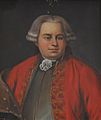|
House of Koháry
The House of Koháry (Hungarian: Koháry-ház) was the name of an ancient and wealthy Hungarian noble family[1] with seats at Csábrág and Szitnya (now Čabraď and Sitno Castle) and the palace of Szentantal (now Svätý Anton, Slovakia). HistoryOriginThe origin of the family is in Zala County in Hungary. In 1470, a "Georg Koháry" is mentioned in the court of King Matthias I Corvinus.[2] The first notable member of the family was Peter Koháry (1564–1629), who was rewarded as the Baron of Csábrág by Emperor Ferdinand II and became commander of the fortress of Érsekújvár. His son Stephan I Koháry (1616–1664) fought against the Turks and died in the battle of Léva.
Counts and generalsIn 1685, Stephan II Koháry (1649–1731) became the first count in his family. He fought against the Ottoman Empire and the Kuruc. After his death, his fortune went to his nephew Andreas Koháry (1694–1757). All Kohárys had been officers and generals of the Habsburg emperors.
Princely titleOn 15 November 1815, the head of the house, Ferenc József Koháry (1760–1826), who served as the Hungarian Chancellor, was given the title of Fürst von Koháry (Prince of Koháry)[3][4] by Emperor Francis I of Austria.[5] House of Saxe-Coburg and Gotha-KoháryUpon the death of Ferenc József, his only surviving child, a daughter named Mária Antónia (1797–1862), was proclaimed "heiress of the name" (fíúsított). When she married in 1816 (January 2), her husband Prince Ferdinand of Saxe-Coburg and Gotha took the name Saxe-Coburg and Gotha-Koháry. Among the descendants of Mária Antónia and Ferdinand are the last emperor of Austria (Charles I), the last four kings of Portugal (Pedro V, Luís I, Carlos I, Manuel II), and the last three tsars of Bulgaria (Ferdinand I, Boris III, Simeon II).
Notable members of the family
Koháry palacesThe Kohárys belonged among the magnates of Hungary. Their holdings were calculated to be around 150,000 hectares, making Princess Maria Antonia Koháry one the richest heiresses in Europe at the time of her marriage to Prince Ferdinand of Saxe-Coburg and Gotha.
See alsoReferences
External links
|
||||||||||||||||||










![Čabraď castle, 1622 feoffed to Peter Koháry[6]](http://upload.wikimedia.org/wikipedia/commons/thumb/b/bb/Cs%C3%A1br%C3%A1g_-_Borovszky.jpg/120px-Cs%C3%A1br%C3%A1g_-_Borovszky.jpg)
![Sitno Castle feoffed 1629 to Peter Koháry, destroyed 1703 during Rákóczi's War of Independence[7]](http://upload.wikimedia.org/wikipedia/commons/thumb/9/98/Sitno_-_hrad.jpg/90px-Sitno_-_hrad.jpg)
![palace of Svätý Anton[8]](http://upload.wikimedia.org/wikipedia/commons/thumb/2/2d/Svaty_anton.jpg/120px-Svaty_anton.jpg)


